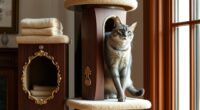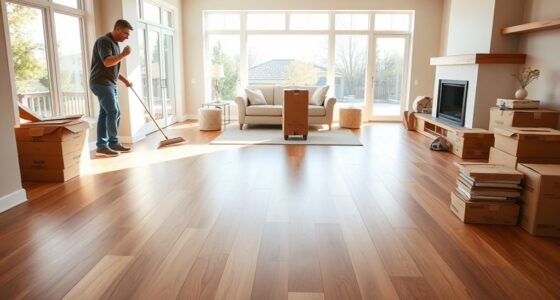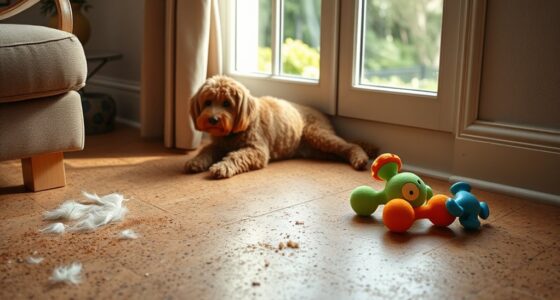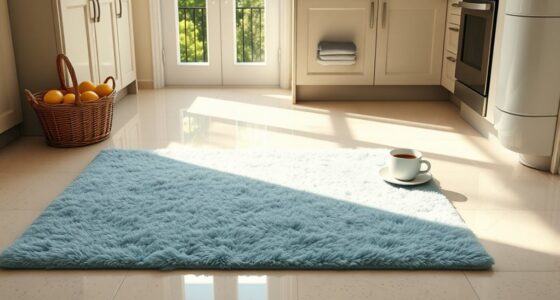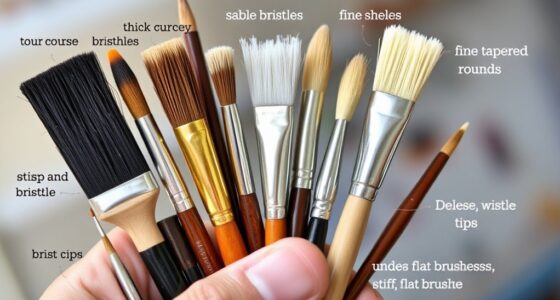To disinfect linoleum floors safely, use mild solutions like diluted white vinegar or a gentle dish soap mixed with water, following the manufacturer’s instructions. Avoid harsh chemicals such as bleach, ammonia, and abrasive scrubbing tools, as they can damage the surface. Proper cleaning techniques include using soft cloths or mops, quick rinsing, and thorough drying after cleaning. Stick to routine maintenance to prevent mold and stains, and discover more tips that keep your floors in top shape.
Key Takeaways
- Use gentle disinfectants like diluted white vinegar or linoleum-safe commercial cleaners per manufacturer instructions.
- Avoid harsh chemicals such as bleach, ammonia-based cleaners, and abrasive scrubbers that can damage the surface.
- Clean with soft cloths or mops, ensuring not to soak the floor, and always rinse and dry thoroughly afterward.
- Refrain from over-wetting during cleaning and immediately dry the floor to prevent mold and stains.
- Regularly sweep or vacuum to remove dirt and moisture, maintaining a clean, mold-resistant linoleum surface.
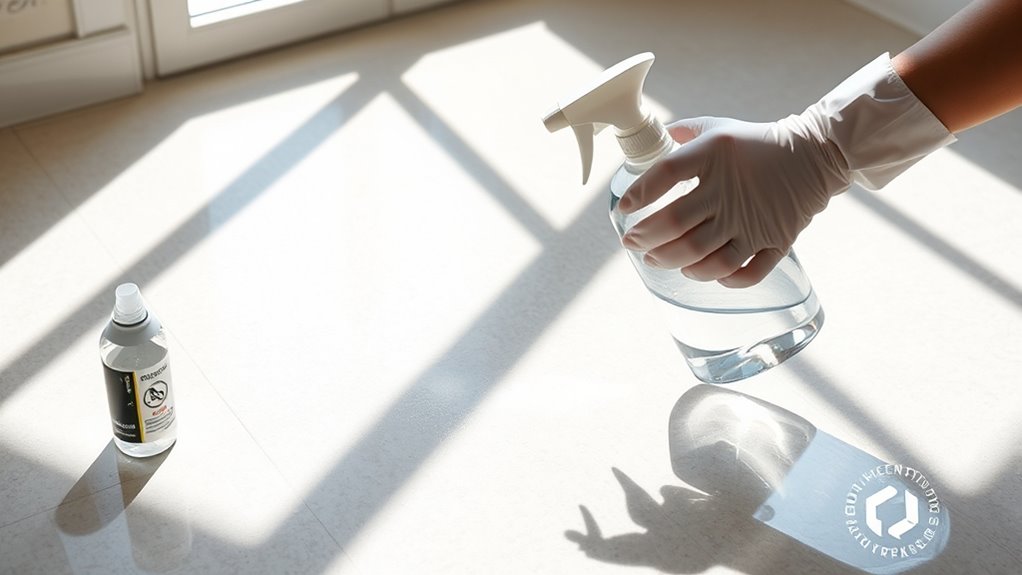
Have you ever wondered how to effectively disinfect your linoleum floors? Keeping your floors clean and safe isn’t just about appearance — it’s about maintaining a healthy environment. Proper disinfection helps prevent mold growth, which can thrive in damp, unclean areas, and keeps stains from setting in, preserving the look of your floors over time. The key is knowing what cleaning agents to use and what to steer clear of, so you can confidently tackle dirt and germs without damaging your linoleum.
To start, choosing the right disinfectant is essential. Mild solutions like diluted white vinegar or a mixture of water and a few drops of dish soap work well for regular cleaning. These options are gentle yet effective at removing surface grime and preventing mold growth by reducing moisture buildup. For tougher stains, you can use a commercial linoleum-safe cleaner designed specifically for resilient stain removal without harming the surface. These products often contain gentle disinfectants that kill bacteria and fungi, reducing the risk of mold proliferation in damp spots. Always follow the manufacturer’s instructions to avoid over-wetting the floor, as excess moisture can promote mold growth and cause the linoleum to warp or peel.
Use gentle disinfectants like diluted vinegar or mild cleaners for effective, safe linoleum floor maintenance.
When disinfecting, avoid harsh chemicals such as bleach or ammonia-based cleaners. Although bleach might seem like a quick fix for germs, it can discolor linoleum and weaken its surface over time. Additionally, using abrasive scrubbers can scratch the floor’s surface, creating tiny crevices where dirt and mold can settle. Instead, opt for soft cloths or mops, and make sure to rinse thoroughly to remove any residue. Keep in mind that moisture is the enemy when it comes to mold prevention; always dry the floor completely after cleaning to inhibit mold spores from settling and growing. Incorporating regular maintenance practices such as sweeping or vacuuming can further reduce the buildup of dirt and moisture, helping to prevent mold growth and stains.
Regular maintenance is your best defense. Frequent sweeping or vacuuming removes dirt that can trap moisture and promote mold growth. When mopping, use a damp cloth rather than soaking the floor, and immediately dry the surface afterward. This routine reduces the chance of stains setting in and keeps your linoleum looking fresh. Remember, stains that are promptly treated with appropriate cleaners are easier to remove and less likely to cause lasting damage. By adopting these simple yet effective practices, you’ll not only keep your floors spotless but also guarantee they stay mold-free and resilient over time.
Frequently Asked Questions
Can I Use Bleach on Linoleum Floors Safely?
You can use bleach on linoleum floors, but you need to prioritize bleach safety to prevent damage. Use a diluted solution, typically one part bleach to ten parts water, and avoid leaving it on the surface for too long. While bleach can disinfect, excessive use may weaken linoleum durability over time. Always rinse thoroughly and dry the floor afterward to keep it looking fresh and prevent deterioration.
How Often Should I Disinfect Linoleum Floors?
You should disinfect your linoleum floors at least once a week to maintain cleanliness and hygiene. Incorporate this into your regular cleaning schedule and adjust based on foot traffic or if spills occur. Use a damp mop with a gentle disinfectant, avoiding harsh chemicals, and make sure you let the floor dry thoroughly. Regular mopping helps prevent dirt buildup and keeps your floors looking fresh and well-maintained.
Are Commercial Disinfectants Safe for Linoleum?
Commercial cleaners can be safe for linoleum if you choose products labeled as suitable for it and follow the manufacturer’s instructions. Always check the label for chemical safety information and avoid harsh chemicals like bleach or ammonia, which can damage the flooring. Using the right commercial disinfectants helps guarantee effective cleaning without harming your linoleum, keeping your floors clean, safe, and well-maintained.
What Natural Disinfectants Are Effective for Linoleum?
Did you know that plant-based disinfectants can kill up to 99.9% of germs? Natural alternatives like vinegar, tea tree oil, and lemon juice are effective for disinfecting linoleum floors. These plant-based disinfectants are safe, eco-friendly, and free of harsh chemicals. Just mix vinegar with water for a simple solution, or add a few drops of tea tree oil for extra antimicrobial power. Always test a small area first!
How Do I Remove Stains After Disinfecting?
To remove stains after disinfecting, you should use stain removal techniques like gently scrubbing with a mixture of baking soda and water or applying a mild vinegar solution. For stubborn stains, consider alternative cleaning agents such as hydrogen peroxide or a commercial linoleum stain remover. Always test a small area first, and avoid harsh chemicals that could damage your floor’s surface. Regular maintenance keeps your linoleum looking fresh and stain-free.
Conclusion
To keep your linoleum floors safe and spotless, choose gentle disinfectants like diluted vinegar or specialized floor cleaners, and avoid harsh chemicals. For example, if you used bleach frequently, it might damage your floor over time. Instead, opt for safe options to preserve its beauty and longevity. By being mindful, you guarantee your floors stay clean and vibrant for years to come, just like the homeowner who switched to a milder cleaner and saw their floor’s color stay bright.

